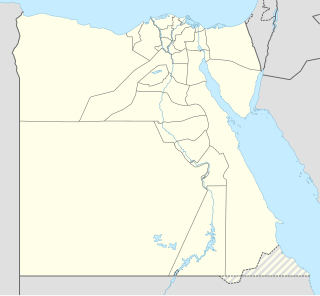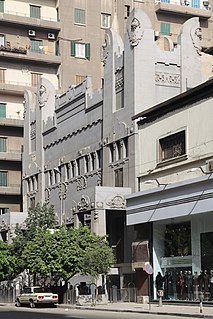 W
WDowntown Cairo, has been the urban center of Cairo, Egypt since the late 19th century, when the district was designed and built.
 W
WThe 6th October Bridge is an elevated highway in central Cairo, Egypt. The 20.5 kilometres (12.7 mi) bridge and causeway crosses the Nile twice from the west bank suburbs, east through Gezira Island to Downtown Cairo, and on to connect the city to the Cairo International Airport to the east.
 W
WAbdeen Palace is a historic Cairo palace, and one of the official residences and the principal workplace of the President of Egypt, located above Qasr el-Nil Street in eastern Downtown Cairo, Egypt.
 W
WThe Abdeen Palace incident was a military confrontation that took place on 4 February 1942 at Abdeen Palace in Cairo, and almost resulted in the forced abdication of King Farouk I. It is considered a landmark in the history of Egypt.
 W
WCafé Riche which opened in 1908 at 29th of Talaat Harb Street, is one of the most renowned landmarks in downtown Cairo. At various times a meeting place for intellectuals and revolutionaries, the café witnessed many historically significant events over the 20th century. It is said to be where King Farouk saw his second wife, Nariman Sadek; where the perpetrator of the 1919 failed assassination attempt on Egypt's last Coptic Prime Minister, Youssef Wahba Pacha lay in wait for his target; and where several members of the resistance during the 1919 revolution met the basement to organize their activities and print their flyers. Patrons included the political novelist Naguib Mahfouz and the then-future president Gamal Abdel Nasser.
 W
WThe Cairo fire, also known as Black Saturday, was a series of riots that took place on 26 January 1952, marked by the burning and looting of some 750 buildings—retail shops, cafes, cinemas, hotels, restaurants, theatres, nightclubs, and the city's Opera House—in downtown Cairo. The direct trigger of the riots was the killing by British occupation troops of 50 Egyptian auxiliary policemen in the city of Ismaïlia in a massacre one day earlier. The spontaneous anti-British protests that followed these deaths were quickly seized upon by organized elements in the crowd, who burned and ransacked large sectors of Cairo amidst the unexplained absence of security forces. The fire is thought by some to have signalled the end of the Kingdom of Egypt. The perpetrators of the Cairo Fire remain unknown to this day, and the truth about this important event in modern Egyptian history has yet to be established. The disorder that befell Cairo during the 1952 fire has recently been compared to the chaos that followed the anti-government protests of 25 January 2011, which saw demonstrations take place amidst massive arson and looting, an inexplicable withdrawal of the police and organized prison-breaking.
 W
WThe Museum of Egyptian Antiquities, known commonly as the Egyptian Museum or Museum of Cairo, in Cairo, Egypt, is home to an extensive collection of ancient Egyptian antiquities. It has 120,000 items, with a representative amount on display, the remainder in storerooms. Built in 1901 by the Italian construction company Garozzo-Zaffarani to a design by the French architect Marcel Dourgnon, the edifice is one of the largest museums in the region. As of March 2019, the museum is open to the public. In 2021 the museum is due to be superseded by the new Grand Egyptian Museum at Giza.
 W
WThe Headquarters of the Arab League is located in Tahrir Square and near the downtown business district of Cairo, Egypt. The headquarters building has views of the Nile River and Qasr al-Nil Bridge just to the west.
 W
WKhairy Pasha Palace is a neo-Mameluk building and former palace of Khairy Pasha, located on 113 Qasr El Eyni Street, in Tahrir Square, Cairo. It served as the American University in Cairo's Tahrir Square campus since 1920 until 2008 when the new campus was inaugurated in New Cairo. The building in the photograph on the right was originally the Girls' School of the Greek Community of Cairo. In 1964 it was sold to the AUC and served as the Greek Campus.
 W
WThe Ministry of Foreign Affairs of the Arab Republic of Egypt is the Egyptian government ministry which oversees the foreign relations of Egypt. On 17 July 2014 Sameh Shoukry was appointed Minister of Foreign Affairs.
 W
WQasr El Eyni Street is one of the oldest streets in downtown Cairo, Egypt.
 W
WThe Qasr El Nil Bridge, also commonly spelled Kasr El Nil Bridge, is a historic structure dating from 1931 which replaced the first bridge to span the Nile River in central Cairo, Egypt. It connects Tahrir Square in downtown Cairo to the modern Cairo Opera complex toward the southern end of Gezira Island. At the bridge's east and west approaches are four famous large bronze lion statues; they are late 19th-century works by Henri Alfred Jacquemart, French sculptor and animalier. The newer and wider 6th October Bridge parallels its route 0.8 kilometres (0.50 mi) just to the north.
 W
WQasr El Nil Street is a street in downtown Cairo, Egypt, one of the biggest streets in Cairo, with many businesses, restaurants, and an active nightlife.
 W
WThe Sha'ar Hashamayim Synagogue is located in Cairo, Egypt. The synagogue was also known as Temple Ismailia and the Adly Street Synagogue.
 W
WShepheard's Hotel was the leading hotel in Cairo and one of the most celebrated hotels in the world from the middle of the 19th century until its destruction in 1952 during the Cairo Fire. Five years after the original hotel was destroyed, a new one was built nearby and was named the Shepheard Hotel.
 W
WTahrir Square, also known as "Martyr Square", is a major public town square in downtown Cairo, Egypt. The square has been the location and focus for political demonstrations in Cairo, most notably those that led to the 2011 Egyptian revolution and the resignation of President Hosni Mubarak.
 W
WTalaat Harb Street is a historic street in downtown Cairo, Egypt, connecting Tahrir Square and Talaat Harb Square.
 W
WThe Mogamma is a government building in Cairo, Egypt. The Mogamma was the result of a series of master plans for the Qasr el Nil area, which used to be occupied by the British barracks. In 1945 when King Farouk ordered the demolition of the barracks upon the departure of British troops from the area, a series of urban planning proposals ensued. The idea for a centralised, all-in-one administrative building emerged from the 1945 plans. Construction began in 1946, and ended in 1949. The building's style reflects typical 1940s modernism, and government buildings in the same style can be found in Buffalo, New York, and Paris. Contrary to popular belief, there is no Soviet association or inspiration, and the building was not constructed by the government of Egypt's second President, Gamal Abdel Nasser. Indeed, Nasser did not become the leader of Egypt until November 1954, several years after the building was completed.